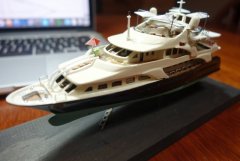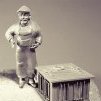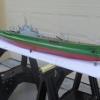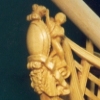Supplies of the Ship Modeler's Handbook are running out. Get your copy NOW before they are gone! Click on photo to order.
×
-
Posts
993 -
Joined
-
Last visited
Reputation Activity
-
 Wintergreen got a reaction from Omega1234 in Beavers Prize 1777 by Mike Y - 1:48 - POF - Hahn style
Wintergreen got a reaction from Omega1234 in Beavers Prize 1777 by Mike Y - 1:48 - POF - Hahn style
Hej Mike,
I confess, I just ran through your log, but what you've achieve so far looks great.
And in the living room... I silently went "holy c**p" when I saw the picture after you planed the planks...
Let me grab a chair here at the side and I will cheer you on as you go.
-
 Wintergreen got a reaction from mtaylor in Beavers Prize 1777 by Mike Y - 1:48 - POF - Hahn style
Wintergreen got a reaction from mtaylor in Beavers Prize 1777 by Mike Y - 1:48 - POF - Hahn style
Hej Mike,
I confess, I just ran through your log, but what you've achieve so far looks great.
And in the living room... I silently went "holy c**p" when I saw the picture after you planed the planks...
Let me grab a chair here at the side and I will cheer you on as you go.
-
 Wintergreen reacted to Mike Y in Beavers Prize 1777 by Mike Y - 1:48 - POF - Hahn style
Wintergreen reacted to Mike Y in Beavers Prize 1777 by Mike Y - 1:48 - POF - Hahn style
Thanks for the comments and likes!
The idea with soft inner side of the clamps paid off, it flexes in difficult tight corners, no damage to the wood or to the finish:
Just need to make more of them, waiting for the shipment of nylon screws.
In a meanwhile, used my mill for the mass production of the scarph joints. Took 40min for two batches, including mill setup and a cleanup!
Rough cut angle planks are fixed in the mill:
First some passes to make them all level.
Then cutting the ends to the depth of the joint (2mm in my case):
Dividing the remaining joint in 2 equal parts, using mill table to measure the distance (do not forget to offset the cutter diameter). Cutting with the same 2mm depth:
The resulting joint is perfect, but a bit too tight, needs force to be assembled, no space for glue.
Sliiightly trimming ends of the planks on a disk sander, carefully with the angles:
And that's it!
Without a mill, it would take me half a day to make all these joints with chisel and file, and they would not be so straight..
Result of the day:
clamps are steamed and fixed into place, left overnight to dry
-
 Wintergreen reacted to AON in HMS Bellerophon 1786 by AON – scale 1:64 – 74-gun 3rd Rate Man of War - Arrogant-Class
Wintergreen reacted to AON in HMS Bellerophon 1786 by AON – scale 1:64 – 74-gun 3rd Rate Man of War - Arrogant-Class
It was September 25th when I tore all the frames off back to the transom and filler pieces.
Today is January 28th and I have finally caught up and installed one frame beyond with another set glued together and drying.
It has been slow going.
The gunport has been cut out, filed to size, checked with my port gauge and will be filed to receive the timbers (upper and lower cills) to finish it off as soon as I get the mating frame in and they have had time to set.
-
 Wintergreen reacted to AON in HMS Bellerophon 1786 by AON – scale 1:64 – 74-gun 3rd Rate Man of War - Arrogant-Class
Wintergreen reacted to AON in HMS Bellerophon 1786 by AON – scale 1:64 – 74-gun 3rd Rate Man of War - Arrogant-Class
So let me introduce myself
CPO and Bosun (Bos'n or Boatswain), 141 Royal Canadian Sea Cadet Corps Bellerophon of Welland, Ontario (1972).
I shrunk my self to 5'-6" from my present 5'-10-1/2"
(glued to a thin piece of wood and that glued to a tiny hex nut to keep me upright)
I'll be adding my father (Able Seaman RCNVR 1939-1945) and my grandfather (Able Seaman NRNR 1914-1918) to the crew.
If I find one of my wife (Navy League Wrenette Corps Patrician of Welland) in uniform she will be signed aboard also... women allowed.
The only criteria for family to join is they must be in naval uniform.
I won't likely post again until I get back to at least where I was before I tore frames off.
take care till then.
-
 Wintergreen reacted to AON in HMS Bellerophon 1786 by AON – scale 1:64 – 74-gun 3rd Rate Man of War - Arrogant-Class
Wintergreen reacted to AON in HMS Bellerophon 1786 by AON – scale 1:64 – 74-gun 3rd Rate Man of War - Arrogant-Class
Thank you for the message. You should be aware that I haven't any great skill level and I appreciate I've jumped into the deep end of this pool but find this forum to be my life jacket.
Making some progress.
I find the wood glue does not adhere to the plastic sheet (picture below). It did to the glass, so this is quite a bonus!
I have (as you'll see below, one set of full frames installed, I installed one half of the next set this morning and hope to get the other half up tonight.
I've cut out the next set and need to fine tune the chocks before I glue the pieces together.
-
 Wintergreen reacted to vaddoc in Deben 5-tonner by vaddoc - FINISHED - Scale 1:10 - a Whisstock yard design
Wintergreen reacted to vaddoc in Deben 5-tonner by vaddoc - FINISHED - Scale 1:10 - a Whisstock yard design
Thank you Hakan and John!
After a long brake due to travelling, children's flu and work issues, I finally found some time to work on the boat and I designed on rhino all the beams. First I designed an arc based on the maximum beam and then used segments of it according to the length of each beam.
The beams have 2 widths, 2 and 4 mm. All beams will be made from cherry (or pear) and I will install the 4mm ones. However, the 2 mm ones are short just going from the sheer to the sides of the cabin. I will make these initially from plywood and full length across, so I can arrange all the notches etc to the rest of the beams and after everything else is installed I will swap them for the real thing. I will not make these out of wood as the curve is too great and the grain will be too oblique. The longitudinal beams supporting the cabin top will be laminated from beech (or whatever 0.5 mm strips I have in my timber stash). I will attempt to use PVA glue although I think it is not really going to work.
Enough talking, some photos. This are the templates printed out on paper and glued to 2 mm plywood.
I calculated the bevels for the beams, but they are negligible. Only the first beam has a bevel of 0.5 mm, the next 8 beams, 0.2mm and the rest almost none at all.
The first 4 plywood beams are ready. I forgot though to leave the edges flat so they can rest on the beam selves.
My home made disk sander was playing up so it was time for a bit of an overhaul. Now it runs brilliantly again.
Since my garage was today tidy, I though it would be nice to post a couple of pictures. The admiral has agreed that it will be used primarily for boat building.
I have two large and very solid benches I made myself and a few power tools I have accumulated over the years. You can see my ropewalk, I need to experiment with a few new threads I got.
This is the other side, selves with wood, chemicals etc and my air cleaner on top. The gas heater appears to be dangerously close to the flammable stuff but it is actually alright.
I hope I will make some more progress over the next few days.
Vaddoc
-
 Wintergreen got a reaction from CiscoH in Kågen by Wintergreen - FINISHED - 1:30 - Swedish clinker-built cog work boat - SMALL
Wintergreen got a reaction from CiscoH in Kågen by Wintergreen - FINISHED - 1:30 - Swedish clinker-built cog work boat - SMALL
Okey, last post for the weekend.
Four strakes are on. As Vaddoc noted, they seemed to run high at the stem. Which I knew. This being learning by doing.
But, since wood is such a nice material to work with, things can be adjusted.
First picture. Before.
Second picture. After chisel and sandpaper.
I also have trouble amidships with the run of the planks dipping. No picture on that. Just a note to self.
Have a nice week!
-
 Wintergreen got a reaction from CiscoH in Kågen by Wintergreen - FINISHED - 1:30 - Swedish clinker-built cog work boat - SMALL
Wintergreen got a reaction from CiscoH in Kågen by Wintergreen - FINISHED - 1:30 - Swedish clinker-built cog work boat - SMALL
Thanks for the likes. Glad to see that there are readers.
Anyway, the day went. Grandkid came, and that was that. Now, she's asleep, so some time to type.
About spiling and clinker, or lapstrake, builds. This is my first attempt at this, so there will probably be lessons learned and working experience later on. However, compared to a carvel laid hull where planks fit long side to long side, and you quite easily can force later planks to the edge of the former, the clinker style means the planks overlap each other and thus form a stepped style. You probably know this already. Otherwise Wikipedia will help you understand.
From my short experience there are some major challenges with this.
You cannot force the plank in place sideways, it has to sit nicely. If force is used the overlap will be out of bounds. Hence, every plank needs more or less spiling. These boats are usually all about the shape. You have the sheer as with a carvel build. But with clinker we are reminded by every single strake if the run of the plank is off in some way. No steelers nor drop planks. Not an option. Every. single. strake. runs all the way from stem to stern. The challenge is to get the run of the planks right when the width of the plank changes. Eyeballing, proportional dividers, measure and measure again, then try. If not satisfied - repeat.
Unfortunately it is not as simple as just divide every frame/mould with decided number of strakes, then it will look very odd. As can be seen in my previous pictures the first strakes get wider at stem/stern. After two-three strakes the opposite will be true. All planks are narrower at stem/stern to fit in.
How to solve the issue with spiling. Basically it is the same as for carvel builds. Chuck, Druxey and others have written articles about it.
First I tried with cardboard of approximately same thickness as the planks. Didn't work too well. Hard to handle due to small size. Hard to see adjacent strake.
For the third strake I remembered that, I think, Chuck used transparent tape. It sticks to the moulds, easy to see and mark. Lacking transparent tape I used the regular painters masking tape and found that it was semi-transparent. Good enough.
One thing I picked up from Underhill's book was his practice of gluing thin material to a backing piece of cardboard or paper. My plank material is thin enough to easily be cut by #11, it will however splinter just as easily. With a broad piece of masking tape on one side - problem solved.
That had another advantage I found out later.
Enough text, show me some photos...
Here the cardboard templates are used.
Now, masking tape instead.
Stick tape to a white surface. Connect the dots with a smooth line.
Move tape to plank material and cut. Backing tape on other side.
The advantage with the backing tape is that it can be used as template for the accompanying plank port/starboard. By the way, leave the backing tape as long as possible.
Meaning all the rough shaping is already done. Every plank still need shaping to fit, but saved some time still.
Bending is performed with a dab of water and heatgun. Birch is very adaptable and bends easily. It holds edges fairly well also as can be seen in a previous post.
That was it for today.
To be continued...
-
 Wintergreen got a reaction from CiscoH in Kågen by Wintergreen - FINISHED - 1:30 - Swedish clinker-built cog work boat - SMALL
Wintergreen got a reaction from CiscoH in Kågen by Wintergreen - FINISHED - 1:30 - Swedish clinker-built cog work boat - SMALL
Hi guys,
the day is only half-gone here, but I just had to share this update with you.
First task for today was to clear a path to the shop... about 20cm/8" of snow overnight.
A short business trip took away a couple of days from the week, but back in the shop I made some progress.
Clinker/lapstrake is really something tricky to get right. Spiling and all that. In a later post I will show my trials and tribulations. On the trip I re-read H.A. Underhills chapter about clinker built boats, which was useful.
This far two full strakes are on. The scarphs are just plain butt ended with a backing piece on each. Joggled of course. Later each strake will be of three pieces.
Rubber bands and teak buns keep planks in place. I need to figure out some way to have the clamps not slipping off. Maybe a bit of tape will do the trick with enough friction.
Backing pieces have beveled edges for appearance. Should be pinned also, will see if I do that.
I am really enjoying this build. The result is far from perfect, but this is also my first time doing this. And since I have this first build as a practice run, my second will undoubtedly be better.
To be continued...
-
 Wintergreen got a reaction from CiscoH in Kågen by Wintergreen - FINISHED - 1:30 - Swedish clinker-built cog work boat - SMALL
Wintergreen got a reaction from CiscoH in Kågen by Wintergreen - FINISHED - 1:30 - Swedish clinker-built cog work boat - SMALL
Hi guys!
Thanks for likes and comment.
Progress has been slow despite quite a few hours in the shop.
Why? Preparatory work.
It's like when all you want to do is to get that wallpaper up and instead you find yourself put up drywalls, fill screw holes, and then some sanding and after that more filling and more sanding. And just before you break the seal on the first roll of paper you realize that you need to prime the drywalls otherwise there isn't enough glue in the world that will keep your wallpaper up.
First, a picture to soothen the soul.
With a multi-tool equipped with a drum sander it was quite a quick job to get the skeleton close to shape.
However, to really get it down to specs took some grater care. When I gladly thought I was done prepping I cut the first strake out of cardboard.
Not happy with the run I turned to the book.
Yes, that man has like a lifetime experience of building boats. I have not.
While contemplating the planking I marked every plank on frame five (middle one). Then it appeared to me that the frame templates needed protection and with a sealed surface it would be easier to mark runs and all that.
So first a sealer then a layer of some very old Humbrol paint. Fascinating enough, the paint is something like 20 yrs old and still "usable".
By that I also put an end to this weekends affair in the shop.
In the background can be seen blanks for planking. 20 mm (3/4") in real world translates to 0,67 mm on my work bench. Not that they are EXACTLY 0,67 mm thick, more like 0,7 mm. Close enough me think.
To be continued...
-
 Wintergreen got a reaction from Gahm in US Brig Syren by Gahm - Model Shipways
Wintergreen got a reaction from Gahm in US Brig Syren by Gahm - Model Shipways
Lovely detailing Thomas.
-
 Wintergreen reacted to Gahm in US Brig Syren by Gahm - Model Shipways
Wintergreen reacted to Gahm in US Brig Syren by Gahm - Model Shipways
As long as I still have easy access to the deck I added the anchor cable along with 2 stoppers on each side. The stoppers were built according to the description in Charles G. Davis ‘The Built-Up Ship Model’ consisting of an eye around a thimble (img 1) secured with ‘round seizing’ and with a ‘double wall with ends hitched’ as stopper knot (img 2) at the other end. Img 3 shows the finished stoppers. In img 4 the lanyards are attached (simulated splice). Imgs 5 – 7 show the anchor cable arrangement with the stoppers in place.
Thomas
Img 1
Img 2
Img 3
Img 4
Img 5
Img 6
Img 7
-
 Wintergreen got a reaction from kees de mol in Kågen by Wintergreen - FINISHED - 1:30 - Swedish clinker-built cog work boat - SMALL
Wintergreen got a reaction from kees de mol in Kågen by Wintergreen - FINISHED - 1:30 - Swedish clinker-built cog work boat - SMALL
Okey, last post for the weekend.
Four strakes are on. As Vaddoc noted, they seemed to run high at the stem. Which I knew. This being learning by doing.
But, since wood is such a nice material to work with, things can be adjusted.
First picture. Before.
Second picture. After chisel and sandpaper.
I also have trouble amidships with the run of the planks dipping. No picture on that. Just a note to self.
Have a nice week!
-
 Wintergreen reacted to Jim Lad in Kågen by Wintergreen - FINISHED - 1:30 - Swedish clinker-built cog work boat - SMALL
Wintergreen reacted to Jim Lad in Kågen by Wintergreen - FINISHED - 1:30 - Swedish clinker-built cog work boat - SMALL
Looking good, mate!
John
-
 Wintergreen reacted to vaddoc in Kågen by Wintergreen - FINISHED - 1:30 - Swedish clinker-built cog work boat - SMALL
Wintergreen reacted to vaddoc in Kågen by Wintergreen - FINISHED - 1:30 - Swedish clinker-built cog work boat - SMALL
You are building the boat in an unusual way Hakan! I assume you put the keel on the frames to put the planks on but then you can remove it as the lapstrake acts as stringers. Are you going to insert frames or ribs afterwards?
Looks better after the adjustment, you are on the right path. A thing to consider though, your scarfs are quite substantial and may cause flat areas in the planks closer to the sheer.
Regards
Vaddoc
-
 Wintergreen got a reaction from Piet in Young America 1853 by EdT - FINISHED - extreme clipper
Wintergreen got a reaction from Piet in Young America 1853 by EdT - FINISHED - extreme clipper
The amount of detail in your build Ed, is just breathtaking. Along with the mass of information in your posts. Your work is on a separate level from many of us.
But I must say that the Captain need to give his first mate a sharp word. Those launches can't just lay around on deck like that. They need to be strapped down or at least put to either side of the deck. Right now they make for an obstacle course should one need to hastily move from poop and forward.
-
 Wintergreen got a reaction from Piet in Licorne 1755 by mtaylor - 3/16" scale - French Frigate - from Hahn plans - Version 2.0 - TERMINATED
Wintergreen got a reaction from Piet in Licorne 1755 by mtaylor - 3/16" scale - French Frigate - from Hahn plans - Version 2.0 - TERMINATED
Yep, that's tiny. Looks good though.
Keep it up Mark :-)
-
 Wintergreen got a reaction from kees de mol in Kågen by Wintergreen - FINISHED - 1:30 - Swedish clinker-built cog work boat - SMALL
Wintergreen got a reaction from kees de mol in Kågen by Wintergreen - FINISHED - 1:30 - Swedish clinker-built cog work boat - SMALL
Hi guys,
the day is only half-gone here, but I just had to share this update with you.
First task for today was to clear a path to the shop... about 20cm/8" of snow overnight.
A short business trip took away a couple of days from the week, but back in the shop I made some progress.
Clinker/lapstrake is really something tricky to get right. Spiling and all that. In a later post I will show my trials and tribulations. On the trip I re-read H.A. Underhills chapter about clinker built boats, which was useful.
This far two full strakes are on. The scarphs are just plain butt ended with a backing piece on each. Joggled of course. Later each strake will be of three pieces.
Rubber bands and teak buns keep planks in place. I need to figure out some way to have the clamps not slipping off. Maybe a bit of tape will do the trick with enough friction.
Backing pieces have beveled edges for appearance. Should be pinned also, will see if I do that.
I am really enjoying this build. The result is far from perfect, but this is also my first time doing this. And since I have this first build as a practice run, my second will undoubtedly be better.
To be continued...
-
 Wintergreen got a reaction from popeye the sailor in Licorne 1755 by mtaylor - 3/16" scale - French Frigate - from Hahn plans - Version 2.0 - TERMINATED
Wintergreen got a reaction from popeye the sailor in Licorne 1755 by mtaylor - 3/16" scale - French Frigate - from Hahn plans - Version 2.0 - TERMINATED
Yep, that's tiny. Looks good though.
Keep it up Mark :-)
-
 Wintergreen got a reaction from Rick01 in Enterprize by Rick01 - FINISHED - scale 1:48 - Topsail Schooner
Wintergreen got a reaction from Rick01 in Enterprize by Rick01 - FINISHED - scale 1:48 - Topsail Schooner
Rope coils are fun. Just like ratlines.
Just kidding, you've done a great job with your first scratch project Rick.
Regarding coils, it will help if you wet them with diluted white glue and then coil them, is my experience.
-
 Wintergreen got a reaction from EdT in Young America 1853 by EdT - FINISHED - extreme clipper
Wintergreen got a reaction from EdT in Young America 1853 by EdT - FINISHED - extreme clipper
The amount of detail in your build Ed, is just breathtaking. Along with the mass of information in your posts. Your work is on a separate level from many of us.
But I must say that the Captain need to give his first mate a sharp word. Those launches can't just lay around on deck like that. They need to be strapped down or at least put to either side of the deck. Right now they make for an obstacle course should one need to hastily move from poop and forward.
-
 Wintergreen got a reaction from Moab in Kågen by Wintergreen - FINISHED - 1:30 - Swedish clinker-built cog work boat - SMALL
Wintergreen got a reaction from Moab in Kågen by Wintergreen - FINISHED - 1:30 - Swedish clinker-built cog work boat - SMALL
Okey, last post for the weekend.
Four strakes are on. As Vaddoc noted, they seemed to run high at the stem. Which I knew. This being learning by doing.
But, since wood is such a nice material to work with, things can be adjusted.
First picture. Before.
Second picture. After chisel and sandpaper.
I also have trouble amidships with the run of the planks dipping. No picture on that. Just a note to self.
Have a nice week!
-
 Wintergreen got a reaction from kees de mol in Kågen by Wintergreen - FINISHED - 1:30 - Swedish clinker-built cog work boat - SMALL
Wintergreen got a reaction from kees de mol in Kågen by Wintergreen - FINISHED - 1:30 - Swedish clinker-built cog work boat - SMALL
Thanks for the likes. Glad to see that there are readers.
Anyway, the day went. Grandkid came, and that was that. Now, she's asleep, so some time to type.
About spiling and clinker, or lapstrake, builds. This is my first attempt at this, so there will probably be lessons learned and working experience later on. However, compared to a carvel laid hull where planks fit long side to long side, and you quite easily can force later planks to the edge of the former, the clinker style means the planks overlap each other and thus form a stepped style. You probably know this already. Otherwise Wikipedia will help you understand.
From my short experience there are some major challenges with this.
You cannot force the plank in place sideways, it has to sit nicely. If force is used the overlap will be out of bounds. Hence, every plank needs more or less spiling. These boats are usually all about the shape. You have the sheer as with a carvel build. But with clinker we are reminded by every single strake if the run of the plank is off in some way. No steelers nor drop planks. Not an option. Every. single. strake. runs all the way from stem to stern. The challenge is to get the run of the planks right when the width of the plank changes. Eyeballing, proportional dividers, measure and measure again, then try. If not satisfied - repeat.
Unfortunately it is not as simple as just divide every frame/mould with decided number of strakes, then it will look very odd. As can be seen in my previous pictures the first strakes get wider at stem/stern. After two-three strakes the opposite will be true. All planks are narrower at stem/stern to fit in.
How to solve the issue with spiling. Basically it is the same as for carvel builds. Chuck, Druxey and others have written articles about it.
First I tried with cardboard of approximately same thickness as the planks. Didn't work too well. Hard to handle due to small size. Hard to see adjacent strake.
For the third strake I remembered that, I think, Chuck used transparent tape. It sticks to the moulds, easy to see and mark. Lacking transparent tape I used the regular painters masking tape and found that it was semi-transparent. Good enough.
One thing I picked up from Underhill's book was his practice of gluing thin material to a backing piece of cardboard or paper. My plank material is thin enough to easily be cut by #11, it will however splinter just as easily. With a broad piece of masking tape on one side - problem solved.
That had another advantage I found out later.
Enough text, show me some photos...
Here the cardboard templates are used.
Now, masking tape instead.
Stick tape to a white surface. Connect the dots with a smooth line.
Move tape to plank material and cut. Backing tape on other side.
The advantage with the backing tape is that it can be used as template for the accompanying plank port/starboard. By the way, leave the backing tape as long as possible.
Meaning all the rough shaping is already done. Every plank still need shaping to fit, but saved some time still.
Bending is performed with a dab of water and heatgun. Birch is very adaptable and bends easily. It holds edges fairly well also as can be seen in a previous post.
That was it for today.
To be continued...
-
 Wintergreen got a reaction from CaptainSteve in Kågen by Wintergreen - FINISHED - 1:30 - Swedish clinker-built cog work boat - SMALL
Wintergreen got a reaction from CaptainSteve in Kågen by Wintergreen - FINISHED - 1:30 - Swedish clinker-built cog work boat - SMALL
Hi guys,
the day is only half-gone here, but I just had to share this update with you.
First task for today was to clear a path to the shop... about 20cm/8" of snow overnight.
A short business trip took away a couple of days from the week, but back in the shop I made some progress.
Clinker/lapstrake is really something tricky to get right. Spiling and all that. In a later post I will show my trials and tribulations. On the trip I re-read H.A. Underhills chapter about clinker built boats, which was useful.
This far two full strakes are on. The scarphs are just plain butt ended with a backing piece on each. Joggled of course. Later each strake will be of three pieces.
Rubber bands and teak buns keep planks in place. I need to figure out some way to have the clamps not slipping off. Maybe a bit of tape will do the trick with enough friction.
Backing pieces have beveled edges for appearance. Should be pinned also, will see if I do that.
I am really enjoying this build. The result is far from perfect, but this is also my first time doing this. And since I have this first build as a practice run, my second will undoubtedly be better.
To be continued...











